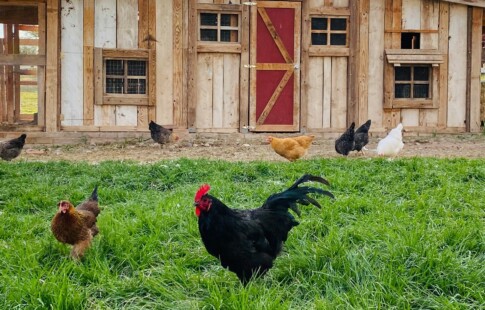
How to Grow Herbs Indoors
We are reader-supported. When you buy through links on our site, we may earn affiliate commission.
In the culinary world, herbs are portions of any green, leafy plant used most often to season and flavor meals. Some of the most common herbs are basil, rosemary, thyme, and oregano. Since herbs are plants, you’d think they can only grow in outdoor gardens.
You might be surprised to learn you can build an herb garden inside your home. With an indoor herb garden, you can harvest small amounts of herbs at a time to elevate your meal, impress guests with delightful scents in your home, and save time and money.
Growing herbs indoors might seem intimidating, but as long as you set up your garden properly, you’ll have fresh herbs at your disposal in no time.
Why Grow Herbs Inside?
A major benefit of building an herb garden is that you’ll always have freshly grown herbs at your fingertips. Home-grown herbs mean no more running to the grocery store when you want to roast rosemary and thyme potatoes or add fresh basil to a margarita pizza.
Aside from their culinary uses, herbs serve other purposes. Below are some examples of popular herbs and interesting ways to use them in your home:
- Rosemary: You can use rosemary as mosquito repellent or boil it as a hair rinse.
- Thyme: You can use thyme to disinfect and clean surfaces around your home.
- Mint: You can use mint to keep mice away.
- Oregano: You can use oregano to fight inflammation and beat the common cold.
As you can see, herbs are useful in more ways than in the kitchen.
How to Grow Herbs Indoors: 5 Steps
Even if you lack a green thumb, growing herbs indoors is easy. Indoor herb gardens require minimal care and grow quite well inside.
Much of the work you’ll do is during the beginning stages. Here are the five steps to follow to learn how to grow herbs indoors.
1. Pick a Sunny Location
To grow well inside, herbs need to receive plenty of natural sunlight. Herb plants need around six hours of sunlight per day to thrive. If possible, choose a sunny location, preferably with a south-facing window.
Some herbs, like mint, parsley, and thyme, can grow well in west-facing windows. If your herbs are not growing, have unusually long stems or grow small leaves, they may not have enough sunlight.
Suppose you live in an apartment or condo without windows. In that case, buy a grow light — which mimics natural sunlight —and place your herbs underneath it for optimal growth.
2. Buy Containers With Drainage
Herbs need to be in containers with enough drainage. Letting herbs sit in waterlogged soil can stunt their growth or even kill them. If you place your herb garden on a windowsill or tabletop, place your herb containers on a saucer, liner, or drain pan.
You can plant herbs in just about any container, and there are plenty of options to choose from, whether you’re shopping at a local garden center or an online retailer.
Remember that your herb plants will grow, meaning using a small vessel will require you to repot your plant sooner rather than later. Use a premium potting mix to ensure your herbs receive the proper nutrients to grow.
3. Choose Seeds vs. Small Plants
The next step is to decide between growing your herbs with seeds or an already existing herb plant. Starting with seeds is relatively easy and inexpensive, but they require more care than a nursery plant.
If you want to pick the budget-friendly option, go with seeds. If you want a hands-off approach to growing and are willing to spend a bit more money, go with nursery plants. Additionally, if you choose to grow herbs using seeds, remember — it will take a few months of growing before you can cut off herbs to use.
4. Water Properly
At some point on your gardening journey, you’ll overwater or underwater a plant — it’s inevitable. One benefit of making a watering mistake with herbs is that afterward, you’ll know how much water your plant needs to thrive.
Regarding your indoor herb garden, it’s critical to water judiciously. Most herbs enjoy moist soil, but overwatering can damage your plants and force you to start the growing process all over again.
It only takes a small amount of water to grow your herbs. Keep soil moist, and if leaves start to turn yellow or wilt, lessen the water you’re using.
5. Harvest Small Amounts at a Time
When it’s time to harvest your herbs, take small pinches at a time. You can cut off the ends of your herb plants with a pair of kitchen scissors or use your index and thumb to pull off the amount you need for its intended use.
For instance, you only need a small number of rosemary sprigs to add to a steak dinner. Avoid removing more than a quarter of the plant at a time, as it causes distress and could even kill your herb plant.
Best Herbs to Grow Indoors
While any herb can grow and thrive indoors, these are the best herbs to start your garden with:
- Basil
- Chives
- Rosemary
- Thyme
- Oregano
- Mint
- Parsley
- Sage
A helpful suggestion is to grow your herbs in separate containers, as you can tend to their individual watering and soil needs. For example, basil likes consistent moisture. Mediterranean herbs like oregano, thyme, and rosemary grow best with judicious watering.
It can be hard to remember which herb needs water or not, so take notes to keep track of your watering schedule. If you have questions about proper watering for your herbs, do a quick Google search! There’s plenty of information online from experienced gardeners on how to care for your herb garden.
Growing Herbs Indoors for Pleasure
You might not use herbs often, but once you grow an herb garden, that’ll change quickly. Easy access to freshly grown herbs will impress guests with your dishes, benefit from other herb uses, and keep your home smelling fresh.
Whether you want to grow herbs as a hobby or spice things up in the kitchen, the steps above will help you get started with an indoor herb garden.
Share on
Like what you read? Join other Environment.co readers!
Get the latest updates on our planet by subscribing to the Environment.co newsletter!
About the author
Rachel Lark
Rachel serves as the Assistant Editor of Environment.co. A true foodie and activist at heart, she loves covering topics ranging from veganism to off grid living.





